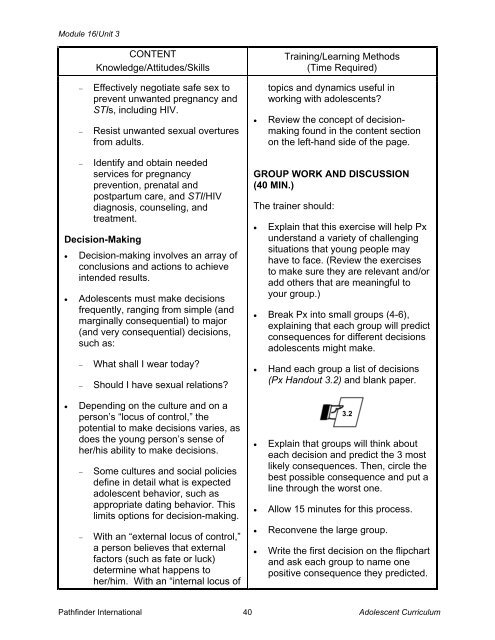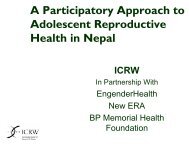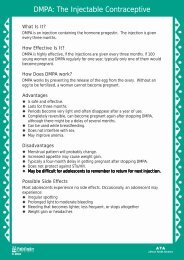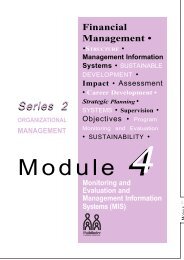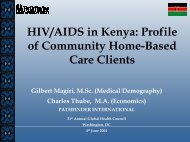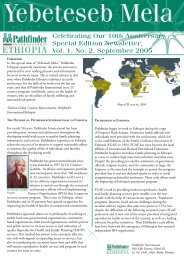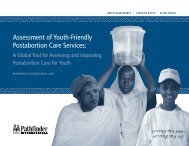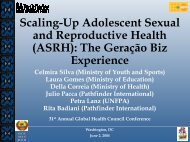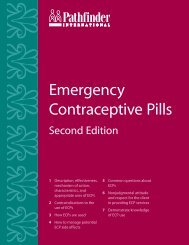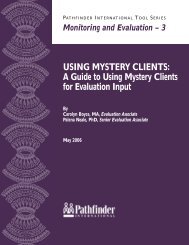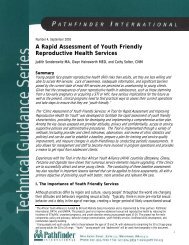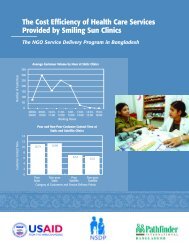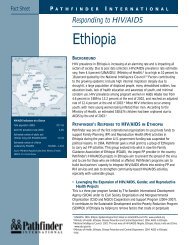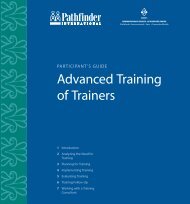reproductive health services for adolescents - Pathfinder International
reproductive health services for adolescents - Pathfinder International
reproductive health services for adolescents - Pathfinder International
You also want an ePaper? Increase the reach of your titles
YUMPU automatically turns print PDFs into web optimized ePapers that Google loves.
Module 16/Unit 3<br />
−<br />
−<br />
CONTENT<br />
Knowledge/Attitudes/Skills<br />
Effectively negotiate safe sex to<br />
prevent unwanted pregnancy and<br />
STIs, including HIV.<br />
Resist unwanted sexual overtures<br />
from adults.<br />
Training/Learning Methods<br />
(Time Required)<br />
topics and dynamics useful in<br />
working with <strong>adolescents</strong><br />
• Review the concept of decisionmaking<br />
found in the content section<br />
on the left-hand side of the page.<br />
−<br />
Identify and obtain needed<br />
<strong>services</strong> <strong>for</strong> pregnancy<br />
prevention, prenatal and<br />
postpartum care, and STI/HIV<br />
diagnosis, counseling, and<br />
treatment.<br />
Decision-Making<br />
• Decision-making involves an array of<br />
conclusions and actions to achieve<br />
intended results.<br />
• Adolescents must make decisions<br />
frequently, ranging from simple (and<br />
marginally consequential) to major<br />
(and very consequential) decisions,<br />
such as:<br />
−<br />
−<br />
What shall I wear today<br />
Should I have sexual relations<br />
• Depending on the culture and on a<br />
person’s “locus of control,” the<br />
potential to make decisions varies, as<br />
does the young person’s sense of<br />
her/his ability to make decisions.<br />
−<br />
−<br />
Some cultures and social policies<br />
define in detail what is expected<br />
adolescent behavior, such as<br />
appropriate dating behavior. This<br />
limits options <strong>for</strong> decision-making.<br />
With an “external locus of control,”<br />
a person believes that external<br />
factors (such as fate or luck)<br />
determine what happens to<br />
her/him. With an “internal locus of<br />
GROUP WORK AND DISCUSSION<br />
(40 MIN.)<br />
The trainer should:<br />
• Explain that this exercise will help Px<br />
understand a variety of challenging<br />
situations that young people may<br />
have to face. (Review the exercises<br />
to make sure they are relevant and/or<br />
add others that are meaningful to<br />
your group.)<br />
• Break Px into small groups (4-6),<br />
explaining that each group will predict<br />
consequences <strong>for</strong> different decisions<br />
<strong>adolescents</strong> might make.<br />
• Hand each group a list of decisions<br />
(Px Handout 3.2) and blank paper.<br />
3.2<br />
• Explain that groups will think about<br />
each decision and predict the 3 most<br />
likely consequences. Then, circle the<br />
best possible consequence and put a<br />
line through the worst one.<br />
• Allow 15 minutes <strong>for</strong> this process.<br />
• Reconvene the large group.<br />
• Write the first decision on the flipchart<br />
and ask each group to name one<br />
positive consequence they predicted.<br />
<strong>Pathfinder</strong> <strong>International</strong><br />
40<br />
Adolescent Curriculum


